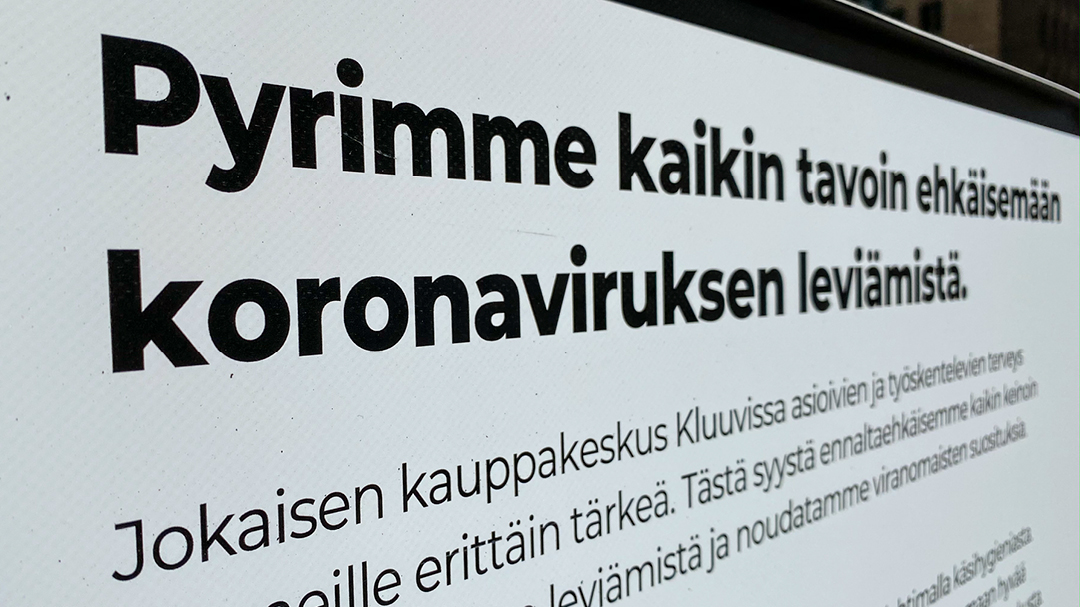Press release by the Ministry of Social Affairs and Health and the Finnish Institute for Health and Welfare
Growth rate of new COVID-19 cases appears to have levelled off — rapid developments in epidemic possible

Rapid developments at regional level are typical of the current epidemiological situation. At the national level, the incidence of new COVID-19 cases, the number of tested samples and the percentage of positive samples of all tested samples have remained more or less at the same level for the last few weeks. The COVID-19 situation in Vaasa is on the wane, and thanks to prompt action, many other regions have also succeeded in breaking transmission chains. The need for hospital care has remained moderate.
During the period of 19–25 October, a total of 1,221 new cases were reported to the communicable diseases register, while in the previous week the number of reported cases was 1,257. The incidence of new cases was 22.0 per 100,000 inhabitants, while in the previous week it was 22.7. Currently, the estimated basic reproduction number is 1.25–1.35, with a 90 per cent probability.
Regional measures are still key to curbing spread of epidemic
Timely and sufficiently extensive measures at the regional level can help address local epidemiological situations effectively. Such measures play a key role in combating the epidemic. Weekly monitoring proves how quickly the spread of the epidemic can slow down when regional and local measures and restrictions are introduced and transmission chains are successfully traced. Tracing of transmission chains has also become easier in Helsinki and Uusimaa; the source of infection was unclear in only less than half of the cases in the region.
Regions give their own overall assessment reports on the development of the epidemic (baseline, acceleration phase, community transmission phase) once a week. According to the reports issued on 28 October 2020, the Vaasa Hospital District is in the community transmission phase and five other regions are in the acceleration phase: the Hospital Districts of Helsinki and Uusimaa, Kanta-Häme, Pirkanmaa and Southwest Finland and the Åland Islands. The Hospital District of South Ostrobothnia has reported having returned to a stable level from the acceleration phase. In all other hospital districts, the epidemic is at a stable level.
Regions take determined action to identify sources of infections
During the period of 19–25 October, the source of infection was identified in an increasing number of cases compared to the previous week. The source of infection was unclear in about 30–40 per cent of the new cases in Finland. In 60 per cent of the cases with known source of infection, the virus had spread within families, and in 15 per cent of them, the virus had been contracted in various social situations, for example when meeting friends, attending a private event or party.
Cases where the virus had spread through recreational activities accounted for about 10 per cent of the cases with known source. In about 10 per cent of the cases, the virus had spread at workplaces. Educational institutions or daycare centres were considered to be the source of infection in only a small number of infections. During the period of 19–25 October, cases where the virus had been contracted at restaurants were reported much less than before.
Protecting risk groups is important
Currently, most of the new cases are still reported among younger age groups and young adults. The percentage of older age groups of those infected has risen slightly over the past few weeks. During the period of 19–25 October, people under 50 years of age accounted for more than 75 per cent of all cases and people under 30 years of age for more than 40 per cent of the cases. People over 60 years of age accounted for about 10 per cent of the cases. The share of people over 70 years of age was very low, accounting for only a few per cent of the cases.
People over 70 years of age are in the risk group because of their age, and it is still extremely important to protect the people at highest risk of severe illness.
Coronavirus is transmitted efficiently particularly between people who are in close contact for a longer time. People with even the mildest symptoms should not take part in social events, but they should avoid contact with other people and get tested as soon as possible. Each of us can do our part to slow down the spread of coronavirus. It is important that healthy people too avoid close contact with others during the epidemic.
The monitoring report on the epidemic published today and the previous reports are available on the website of the Finnish Institute for Health and Welfare:
- Monitoring coronavirus (Finnish Institute for Health and Welfare), in Finnish
- COVID-19 epidemic: situation in regions, recommendations and restrictions (Finnish Institute for Health and Welfare)
- Situation in intensive care: COVID-19 in intensive care (28 October 2020), in Finnish
Inquiries
Taneli Puumalainen, Chief Physician, Finnish Institute for Health and Welfare, [email protected] (development of the epidemic)
Kari Auranen, Research Professor, Finnish Institute for Health and Welfare, [email protected] (projection models)
Liisa-Maria Voipio-Pulkki, Strategic Director, Ministry of Social Affairs and Health, [email protected] (situational picture and modelling group)
